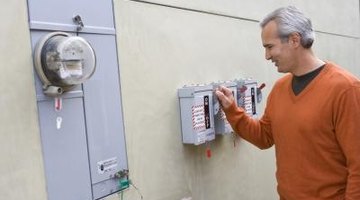What Type of Conduit for Outside?
Electrical conduit is required by electrical code to protect wires from mechanical damage. It is used when wires are exposed on wall surfaces or on the outside of a building. It is available is several different materials, each having their strengths and weaknesses. When using conduit outside it is important to consider how it will hold up to nature's abuse.
PVC Conduit

PVC conduit is commonly used outside because it can be installed with watertight joints. It is a high strength, low cost pipe, and is also rated for below-grade applications. It is available in lengths up to 20 feet and diameters ranging from 1/2 to 5 inches. The size of conduit you choose directly relates to the number of wires inside and their individual gauge. One drawback to PVC is that the sun's ultraviolet rays will eventually break down the material.
Galvanized Rigid Steel Conduit
Rigid steel conduit is a heavy-duty pipe that is used when the risk of mechanical damage is high. It is expensive and more difficult to install. It is available in lengths of 10 feet and diameters ranging from 1/2 to 6 inches. When using ridged steel pipe outdoors it is important to select the galvanized type to prevent rusting.
EMT Conduit
EMT conduit is a thin metal pipe that is easy to bend. It is rated for outdoor use but doesn't hold up as well as PVC, galvanized ridged steel pipe or aluminum. EMT conduit is relatively easy to install because it can be bent with a manual tool. It is available is 10 foot lengths and diameters ranging from 1/2 to 4 inches.
Ridgid Aluminum Conduit
Ridged aluminum conduit is both strong and has natural abilities to resist corrosion. It is expensive and requires a mechanical tool to bend. It is typically used in industrial or commercial applications because of its superior resistance to corrosion.
Writer Bio
Bob White began his writing career in 2006. Working in sales, he was a technical writer tasked with responding to requests for proposal. White has a Bachelor of Arts in computer science and a diploma in home inspection. He has also worked in construction, landscaping and the pool industry for more than 15 years.
Photo Credits
- Jupiterimages/Brand X Pictures/Getty Images
More Articles



